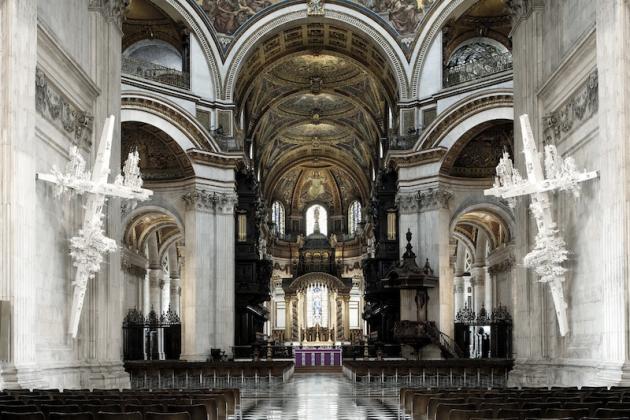Gerry Judah’s has unveiled his much anticipated twin sculptures in the nave of St Paul’s Cathedral. The work has been installed to commemorate the 100th anniversary of the beginning of the First World War. Their white cruciform shapes evoking the meticulously maintained war graves of northern France and further afield, in fact represent an utterly contemporary questioning of the continued need for warfare.
Bearing the shells of bombed out residential blocks, Judah’s crosses bring to mind the horrors of total war, to images of which we have become almost inured. They ask us to think of Verdun, Hamburg or Hiroshima, of Beirut, Baghdad or Homs. The wantonness and wastefulness they represent should also remind us of the ravaged earth of the First World War, of the millions of young men sacrificed defending or attacking mere yards of mud.
Judah wants us to see in these works the waste and pity of all wars; perhaps especially he wants to suggest that the current Middle Eastern wars are to an extent the consequence of that First World War, of the chopping up of the Ottoman Empire that followed it.
In the damaged buildings there is a further element, too, of revelation, for destruction is a kind of perverse archaeology. Bombs expose the private, the personal, the intimate; the skin of a building ripped away to show lived lives ended in a single blast. Mass deaths are made of thousands of individual tragedies.
This is public art unafraid of the obvious, not footling with self-expression or abstract aesthetics, but with the world as it was and as it is. And yet in the embedded themes are the great abstracts: God, life, death, love, despair and hope.
St Paul’s Cathedral itself is of course not unfamiliar with conflict. The current building is the fifth Cathedral. The first was built on the site of a temple dedicated to the Roman goddess Diana. The second St Paul’s was destroyed by the Vikings. And just after Christmas 1940, the Luftwaffe dropped twenty-eight incendiary bombs on or around the Cathedral, almost all of which were defused before exploding. Its survival was miraculous, and memorably expressed in Herbert Mason’s famous photograph of the dome intact above the smoke of blitzed London.
But war is rarely as simple as good versus evil, and the multiple ambiguities in Gerry Judah’s art brings home to us this fact. While the work might initially suggest that we have learned little, on reflection the very existence of the Cathedral and of the art that adorns it, both Judah’s and that of previous artists, represents a triumph of hope over despair, and an unflagging determination to make the world a more peaceful place.
Canon Mark Oakley, Chancellor of St Paul’s Cathedral, says: “Gerry Judah’s striking sculptures confront us with the reality of a War that saw thousands and thousands of young people from around the world buried with white crosses over their remains. They also provoke us into interrogating the present world and the landscapes we casually view on the news every day, scarred and agonised by military hate in the hearts and minds of those who survive. Gerry Judah’s work ruptures the symmetry of the Cathedral just as war works breaks down human harmony. Placed where they are, we are invited to walk through them, and the failure and pain they represent, into a sacred space of hope where people in all our diversity are invited to come together to worship, to respect and to learn from each other. It is a work that starkly asks of us what it must now mean for us to be loyal to our shared future.”
Born in 1951 in Calcutta, India, Gerry Judah moved to London with his family at the age of ten years old. A graduate of Goldsmiths College and Slade School of Fine Art, Judah has worked on settings for some of the UK’s leading theatres, museums and public spaces, including the Royal Opera House, Royal Shakespeare Company, British Museum, English National Opera and Royal Ballet. In 2000, the Imperial War Museum commissioned Judah to create a large-scale model of the selection ramp in Auschwitz- Birkenau for the Holocaust Exhibition, opened by Queen Elizabeth II. The project signalled a shift in the thematics of Judah’s work towards art borne of his reflections on political, historical and environmental issues, culminating in collaborations with organisations including Christian Aid and the British High Commission, India.
Gerry Judah’s work has been exhibited at Whitechapel Gallery, Camden Arts Centre and Yorkshire Sculpture Park, and has entered many international public and private collections including the Saatchi Collection London, and the Imperial War Museum.

